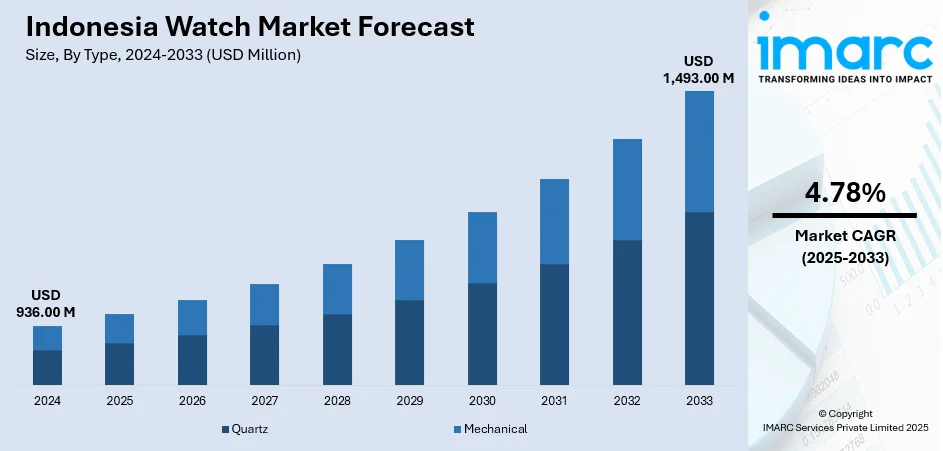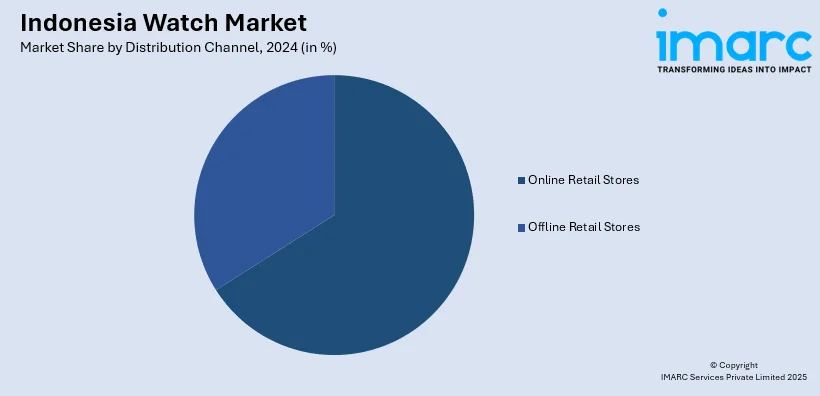
Indonesia Watch Market Size, Share, Trends and Forecast by Type, Price Range, Distribution Channel, End User, and Region, 2025-2033
Indonesia Watch Market Overview:
The Indonesia watch market size reached USD 936.00 Million in 2024. The market is projected to reach USD 1,493.00 Million by 2033, exhibiting a growth rate (CAGR) of 4.78% during 2025-2033. The market is witnessing consistent growth, driven by increasing demand for both traditional and smart timepieces. Offering a wide selection across price ranges and styles, the market appeals to a diverse consumer base, from luxury buyers to tech-savvy individuals. The rise of digital retail and changing lifestyle preferences are shaping new purchasing patterns, particularly among younger consumers. As trends shift and regional demand grows, there is a steady expansion in the Indonesia watch market share.
|
Report Attribute
|
Key Statistics
|
|---|---|
|
Base Year
|
2024 |
|
Forecast Years
|
2025-2033
|
|
Historical Years
|
2019-2024
|
| Market Size in 2024 | USD 936.00 Million |
| Market Forecast in 2033 | USD 1,493.00 Million |
| Market Growth Rate 2025-2033 | 4.78% |
Indonesia Watch Market Trends:
E-commerce and Retail Network Synergy
As of July 2025, Indonesia had 9,187 operational watch retail outlets, with over 1,700 located in Jakarta alone. This extensive presence reflects the strong role of physical retail, now increasingly complemented by digital expansion. The convergence of e-commerce and in-store shopping is reshaping how consumers engage with watch brands. Mobile-first browsing, integrated promotions, and real-time inventory access have enhanced customer experience, particularly for those in tier-2 and tier-3 cities. Watch retailers are building omnichannel strategies, linking social platforms, online marketplaces, and brick-and-mortar stores into seamless shopping experience. The evolution of logistics and payment systems has expanded accessibility across various price segments, from entry-level fashion watches to high-end mechanical models. Consumer demand is further encouraged by influencers and seasonal campaigns that spotlight watches as both functional tools and fashion statements. These developments are fostering competitive diversity and accessibility, transforming shopping into a more curated, digital-physical hybrid experience. With a solid retail infrastructure supported by digital acceleration, Indonesia watch market growth is being steadily reinforced by both reach and relevance across demographics and income groups.

To get more information on this market, Request Sample
Smartwatch Adoption Among Younger Consumers
In March 2025, surveys noted a sharp uptick in wearable tech usage, with smartwatches gaining prominence among Indonesia’s youth population. This shift reflects broader lifestyle changes as Gen Z and millennials increasingly prioritise health, convenience, and connectivity. Features like step tracking, sleep monitoring, app syncing, and notification alerts are seen as essential for work-life balance and daily performance. The ability to personalise watch faces and bands also supports individual style expression. Retailers and local distributors have capitalised on this momentum by promoting hybrid designs that merge analog aesthetics with digital functionality. These timepieces serve a dual purpose offering classic form with cutting-edge function. Additionally, government health awareness campaigns and mobile app integration are reinforcing wearables as wellness tools. The increasing affordability of entry-level smartwatches has expanded the category's reach beyond urban centres, attracting consumers from a variety of socioeconomic backgrounds. These preferences are gradually redefining the country’s watch segment. As a result, Indonesia watch market trends now reflect a strong orientation toward wearable tech, driving demand in both digital-first and hybrid timekeeping formats.
Rise of Local Storytelling in Watch Design
Since February 2024, the demand for watches that reflect Indonesian heritage and craftsmanship has grown significantly, highlighted by the international recognition of local brands such as Bandung-based Pala Nusantara. Designs featuring native materials like teak wood, batik motifs, and storytelling elements rooted in Indonesian culture are resonating with buyers seeking identity-driven fashion. These locally made timepieces do more than tell time they tell stories. The rising popularity of regionally inspired collections reflects a shift away from mainstream global aesthetics toward personalised, meaningful luxury. Buyers appreciate products that offer a sense of provenance, purpose, and pride in national culture. Local workshops and designers are also responding with small-batch production models, prioritising environmental responsibility and artisanal value. Timepieces are now frequently tied to heritage preservation efforts, using recycled materials and traditional handcrafting methods. These innovations are helping to define a new sector within the country’s fashion and lifestyle space. Such unique positioning is enabling local watchmakers to differentiate their offerings and strengthen their impact within and beyond.
Indonesia Watch Market Segmentation:
IMARC Group provides an analysis of the key trends in each segment of the market, along with forecasts at the country and regional levels for 2025-2033. Our report has categorized the market based on type, price range, distribution channel, and end user.
Type Insights:
- Quartz
- Mechanical
The report has provided a detailed breakup and analysis of the market based on the type. This includes quartz and mechanical.
Price Range Insights:
- Low-Range
- Mid-Range
- Luxury
A detailed breakup and analysis of the market based on the price range have also been provided in the report. This includes low-range, mid-range, and luxury.
Distribution Channel Insights:

- Online Retail Stores
- Offline Retail Stores
The report has provided a detailed breakup and analysis of the market based on the distribution channel. This includes online retail stores and offline retail stores.
End User Insights:
- Men
- Women
- Unisex
A detailed breakup and analysis of the market based on the end user have also been provided in the report. This includes men, women, and unisex.
Regional Insights:
- Java
- Sumatra
- Kalimantan
- Sulawesi
- Others
The report has also provided a comprehensive analysis of all the major regional markets, which include Java, Sumatra, Kalimantan, Sulawesi, and others.
Competitive Landscape:
The market research report has also provided a comprehensive analysis of the competitive landscape. Competitive analysis such as market structure, key player positioning, top winning strategies, competitive dashboard, and company evaluation quadrant has been covered in the report. Also, detailed profiles of all major companies have been provided.
Indonesia Watch Market News:
- December 2024: Seiko Indonesia has unveiled its third Indonesia Exclusive Limited Edition watch in collaboration with Tambling Wildlife Nature Conservation. This special edition timepiece is inspired by the Sumatran tiger and reflects Seiko’s ongoing commitment to environmental awareness and preservation. The launch highlights Seiko’s dedication to blending craftsmanship with meaningful causes. Through this initiative, the brand strengthens its connection with Indonesian consumers by celebrating the nation’s rich biodiversity and supporting local conservation efforts in Indonesia’s natural heritage.
Indonesia Watch Market Report Coverage:
| Report Features | Details |
|---|---|
| Base Year of the Analysis | 2024 |
| Historical Period | 2019-2024 |
| Forecast Period | 2025-2033 |
| Units | Million USD |
| Scope of the Report |
Exploration of Historical Trends and Market Outlook, Industry Catalysts and Challenges, Segment-Wise Historical and Future Market Assessment:
|
| Types Covered | Quartz, Mechanical |
| Price Ranges Covered | Low-Range, Mid-Range, Luxury |
| Distribution Channels Covered | Online Retail Stores, Offline Retail Stores |
| End Users Covered | Men, Women, Unisex |
| Regions Covered | Java, Sumatra, Kalimantan, Sulawesi, Others |
| Customization Scope | 10% Free Customization |
| Post-Sale Analyst Support | 10-12 Weeks |
| Delivery Format | PDF and Excel through Email (We can also provide the editable version of the report in PPT/Word format on special request) |
Key Questions Answered in This Report:
- How has the Indonesia watch market performed so far and how will it perform in the coming years?
- What is the breakup of the Indonesia watch market on the basis of type?
- What is the breakup of the Indonesia watch market on the basis of price range?
- What is the breakup of the Indonesia watch market on the basis of distribution channel?
- What is the breakup of the Indonesia watch market on the basis of end user?
- What is the breakup of the Indonesia watch market on the basis of the region?
- What are the various stages in the value chain of the Indonesia watch market?
- What are the key driving factors and challenges in the Indonesia watch market?
- What is the structure of the Indonesia watch market and who are the key players?
- What is the degree of competition in the Indonesia watch market?
Key Benefits for Stakeholders:
- IMARC’s industry report offers a comprehensive quantitative analysis of various market segments, historical and current market trends, market forecasts, and dynamics of the Indonesia watch market from 2019-2033.
- The research report provides the latest information on the market drivers, challenges, and opportunities in the Indonesia watch market.
- Porter's five forces analysis assists stakeholders in assessing the impact of new entrants, competitive rivalry, supplier power, buyer power, and the threat of substitution. It helps stakeholders to analyze the level of competition within the Indonesia watch industry and its attractiveness.
- Competitive landscape allows stakeholders to understand their competitive environment and provides an insight into the current positions of key players in the market.
Need more help?
- Speak to our experienced analysts for insights on the current market scenarios.
- Include additional segments and countries to customize the report as per your requirement.
- Gain an unparalleled competitive advantage in your domain by understanding how to utilize the report and positively impacting your operations and revenue.
- For further assistance, please connect with our analysts.
 Request Customization
Request Customization
 Speak to an Analyst
Speak to an Analyst
 Request Brochure
Request Brochure
 Inquire Before Buying
Inquire Before Buying




.webp)




.webp)












